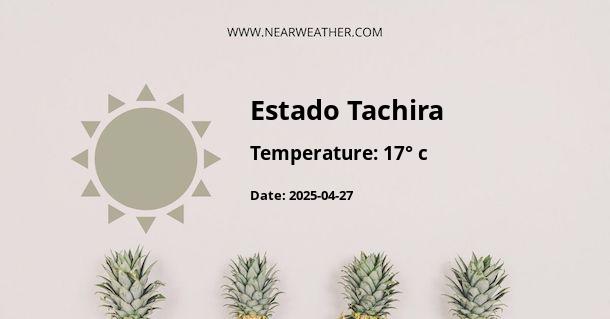Climate and Weather in Estado Táchira, Venezuela
Estado Táchira is a state located in the western part of Venezuela, in the Andes region. The climate in Estado Táchira is greatly influenced by its diverse topography, ranging from high mountain peaks to low-lying valleys. This results in a variety of microclimates throughout the state, each with its own unique weather patterns and characteristics.
Temperature
The temperature in Estado Táchira varies based on the altitude. In the lower-lying areas and valleys, the climate tends to be warmer, with average temperatures ranging from 18°C to 28°C (64°F to 82°F) throughout the year. In the higher altitude mountainous areas, the temperature is cooler, with average temperatures ranging from 10°C to 20°C (50°F to 68°F).
The city of San Cristóbal, which is the capital of Estado Táchira, experiences an average annual temperature of around 22°C (72°F). The temperatures are relatively consistent throughout the year due to its proximity to the equator, resulting in minimal variation between the seasons.
Rainfall
Estado Táchira experiences a distinct wet and dry season. The wet season typically extends from April to November, with the peak of rainfall occurring between May and October. During this period, the state receives a significant amount of rainfall, especially in the mountainous regions and along the western border with Colombia. The average annual rainfall in Estado Táchira ranges from 800mm to 1800mm, with the highest amounts occurring in the mountainous areas.
Microclimates
Due to its diverse topography, Estado Táchira hosts an array of microclimates. The high altitude páramo ecosystems in the mountainous areas have a unique climate characterized by low temperatures, high winds, and regular fog. These areas are known for their distinctive flora and fauna, adapted to the harsh conditions of the páramo.
The valleys and plains in Estado Táchira have a milder climate, making them suitable for agriculture. The fertile soil and favorable climate contribute to the state's agricultural productivity, with crops such as coffee, sugarcane, and vegetables being cultivated in the region.
Weather Hazards
Estado Táchira, like many regions in the Andes, is susceptible to weather-related hazards such as landslides and flash floods, particularly during the rainy season. The rugged terrain and high rainfall can contribute to soil instability, posing risks to communities located in the mountainous areas.
Furthermore, the state is located in a seismically active zone, making it prone to earthquakes. While they are not directly related to climate, earthquakes can have a profound impact on the infrastructure and well-being of the inhabitants of Estado Táchira.
Climate Change Impact
Climate change poses potential challenges for Estado Táchira. The changing precipitation patterns and temperatures could impact the region's agriculture, water resources, and ecosystems. Additionally, changes in the frequency and intensity of extreme weather events could pose risks to the infrastructure and livelihoods of the local communities.
Conclusion
Estado Táchira exhibits a diverse climate influenced by its varied topography. From the warm valleys to the cool mountain peaks, the state's climate offers a range of environments that support diverse ecosystems and human activities. Understanding the nuances of Estado Táchira's climate is essential for sustainable development and the well-being of its residents.
A - Estado Tachira's Latitude is 7.833330 & Longitude is -72.083328.
A - Weather in Estado Tachira is 17° today.
A - Climate Conditions in Estado Tachira shows overcast clouds today.
A - Humidity in Estado Tachira is 79% today.
A - Wind speed in Estado Tachira is 0.72 km/h, flowing at 63° wind direction. today.
